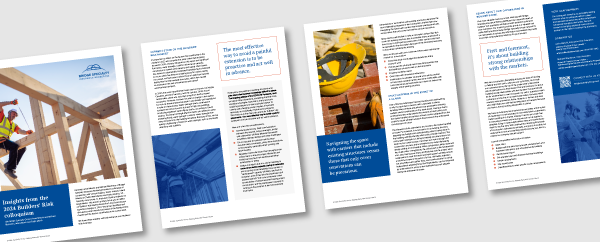
with Bridge Specialty Group’s Amie Meschi and Michael Blackmon, Westchester and Engle Martin
Recently, Amie Meschi and Michael Blackmon of Bridge Specialty Insurance Brokerage hosted a colloquium in conjunction with Vincent Zegers, Senior Advisor, Inland Marine at Chubb Westchester and David Alvarez, VP – Specialty Loss Group, Sr. Executive General Adjuster at Engle Martin. This event’s primary focus was to reflect on Builders’ Risk Market trends from 2023 and discuss expected changes in 2024. The group identified and discussed current trends and issues of the Builders’ Risk market and the factors contributing to its current state.
CLICK HERE TO DOWNLOAD THE FOUR-PAGE WHITE PAPER.
Current state of the Builders’ Risk market
It’s important to reflect on the factors that contributed to the market in 2023 and consider the state of the market going forward in 2024. Primary disrupters in this space are significant fire losses, water damage, a shift in reinsurance capacity, constriction in named wind capacity and supply chain issues. Fire losses to substantially completed buildings have continued to occur, which has been an ongoing issue for carrier panels. As a result, we have seen carriers focus on judicious capacity deployment to help manage loss ratios, which has caused an increase in the rate of extensions and named wind-exposed projects.
In 2023, the most impactful fire losses were in Aurora, Las Vegas, Charlotte, and San Francisco, and the January 29 fire loss in Jacksonville, which was only days away from the first tenant occupancy. However, we have not seen a change in the market for non-cat frame projects because it was already well capitalized to take on these losses. Water damage claims continued to escalate not only in low-rise but also in high-rise buildings, producing significant seven-figure claims. According to David Alvarez, 70 percent of Engle Martin’s claims are related to water (meaning flood), water damage or interior water damage from water intrusion into the building envelope. Because of this, we are seeing a tightening of terms for water damage, such as increased retentions and sublimits.
The most effective way to avoid a painful extension is to be proactive and act well in advance.
Extensions, renovations to existing structures and prior starts also became increasingly difficult to place. The lingering effects of the COVID-19 Pandemic, such as supply chain disruptions, escalating material costs and labor shortages, have led to many accounts requiring extensions to their expiration dates. To comply with changing carrier treaties, it has been necessary to completely rewrite some programs. This leads us to the main pain points for builders’ risk placements. The most effective way to avoid a painful extension is to be proactive and act well in advance.
Here are a few key considerations:
- Communication is key. Fluid communication between the insured, project manager, broker and underwriter will help alleviate last-minute scrambles, delivery delays and other challenges.
- Do not assume an extension will be easy. Assume treaty constraints, policy term restrictions, or lost capacity, especially when working with MGA markets.
- Regularly review the Gantt chart throughout the project term to ensure project milestones are being met and have not experienced either acceleration or delay.
- Delays in projects due to a carrier needing to come off or restrict capacity during an extension are occurring more frequently. New carriers or “replacement” capacity will likely rate back to inception, even if they join the placement with minimal time left. This occurs because of the accumulation of values assumed during project construction, and the replacement capacity is coming on the program at the most exposed time frame.

Renovations or renovations with existing structures represent the most challenging segment of the construction market right now. Navigating the space with carriers that include existing structures versus those that only cover renovations can be precarious.
Many carriers will decline to write a renovation unless they also cover the existing structure due to potential claims scenarios if a loss occurs to both during construction. Other carriers only have an appetite for the renovation because of the increased exposure to loss when including the existing.
Items to discuss with your customer before approaching the
market for a renovation:
- A line-item hard cost budget that details the entire scope of work
- If structural, the structural report that demonstrates that the building is sound to take on the renovation
- Property condition report
- Gantt chart with renovation milestones
- Confirmation on whether structural work will be vertical or horizontal—several carriers are more comfortable with horizontal structural renovation as it does not impact the integrity of the existing structure
What happens in the event of a claim?
One of the key takeaways, beyond capacity and underwriting, is why it’s important to partner with a specialist in claims handling. Many of these placements are syndicated, meaning multiple carriers participate on the same panel. Having a claims professional who understands the nuances of each policy and the claims handling procedures of each carrier assigned from the project’s outset will help advance the process in the unfortunate circumstance of a loss.
One of the key takeaways, beyond capacity and underwriting, is why it’s important to partner with a specialist in claims handling. Many of these placements are syndicated, meaning multiple carriers participate on the same panel. Having a claims professional who understands the nuances of each policy and the claims handling procedures of each carrier assigned from the project’s outset will help advance the process in the unfortunate circumstance of a loss.

The elements of the submission are crucial to the claims handling process. For example, in a renovation to an existing structure, digesting the budget and understanding what is being done to the building will help identify which policy should respond. The critical path schedule is a living, breathing document that is not meant to be a static picture. It evolves as it veers through the construction process and is intended to be visited frequently, ideally weekly, if not biweekly. When calculating a delay claim and the rough order of magnitude, the critical path is the fundamental tool. Also, having your claims professional visit the project upon
assignment to meet the team and build rapport will help ensure a smooth process in the event of a loss. Ultimately, adjusters are storytellers who gather facts, and communication is critical. Independent adjusting firms, like Engle Martin, can be endorsed by underwriters to serve as the dedicated account adjuster during the placement process.
Learn about our capabilities in Builders’ Risk
Your most valuable resource is time. Working with Bridge Specialty Insurance Brokers (BSIB) and our seasoned team of builders’ risk specialists will help provide bespoke options for your customers. Our property practice group is a valuable tool within BSIB and the broader Bridge Specialty Group network for our teammates to access the information and markets they need to provide comprehensive solutions for your insured.
First and foremost, it’s about building strong relationships with the markets.
With new construction (hopefully) showing no signs of slowing or halting any time soon, what can we, as brokers, do to help our customers get to the top of the underwriter’s theoretical pile of submissions on their desks? First and foremost, it’s about building strong relationships with the markets. Our goal should be for underwriters to want to answer our call or questions when a closing is on the line or an opportunity arises. Knowing which markets write renovations, frame, midterm, or homes and even who might help you with that last little piece of capacity because you have a strong working relationship is critical.
We have an extensive list of data points we gather at the outset of marketing. It is not intended to over-underwrite a submission before sending it to market. Instead, it serves as a road map to choosing a market and ensuring we are not up against a deadline, trying to meet subjectivities when an insured hears them for the first time. With underwriters receiving thousands of construction submissions annually, our goal is to enable our underwriter to look at something quickly and say yes, this is a project our company should support.
A good pre-qualified submission includes:
- Gantt chart
- Budget with line item hard and soft costs/proforma for business interruption and a breakdown by building
- Geotechnical report
- Site plan/plot plan with distance between buildings
- Lender requirements
- Site security plan
- Supplementals to meet specific carrier requirements
How can we help?
Our colloquium served as an incredible starting point for what we anticipate will be a deep dive educational series into all the components mentioned throughout the article. We look forward to bringing additional resources and partners to the table to continue the discussion.
CLICK HERE TO DOWNLOAD THE FOUR-PAGE WHITE PAPER.
Contact us
Amie Meschi, Executive Vice President – National Practice Group Leader – Energy and Construction
[email protected] | 404-825-5442
Michael Blackmon, Vice President National Practice Group Leader – Warehousing/Distribution and General Property
[email protected] | 770-633-3588


